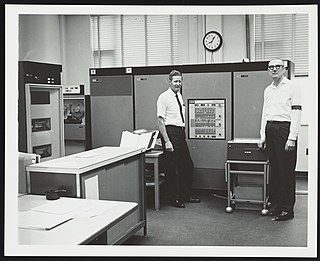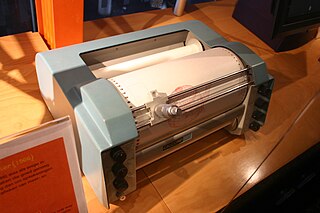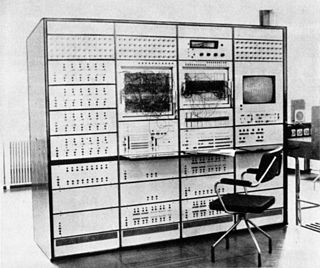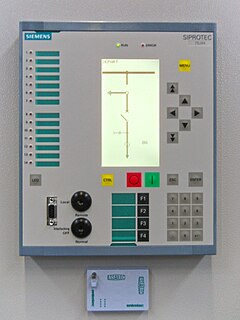
The GE-200 series was a family of small mainframe computers of the 1960s, built by General Electric (GE). GE marketing called the line Compatibles/200 (GE-205/215/225/235). Oddly, the GE-210 of 1960 is not compatible with the rest of the 200 series.

The IBM 1620 was announced by IBM on October 21, 1959, and marketed as an inexpensive scientific computer. After a total production of about two thousand machines, it was withdrawn on November 19, 1970. Modified versions of the 1620 were used as the CPU of the IBM 1710 and IBM 1720 Industrial Process Control Systems.

In electronics, a digital-to-analog converter is a system that converts a digital signal into an analog signal. An analog-to-digital converter (ADC) performs the reverse function.
A music sequencer is a device or application software that can record, edit, or play back music, by handling note and performance information in several forms, typically CV/Gate, MIDI, or Open Sound Control (OSC), and possibly audio and automation data for DAWs and plug-ins.
A distributed control system (DCS) is a computerised control system for a process or plant usually with many control loops, in which autonomous controllers are distributed throughout the system, but there is no central operator supervisory control. This is in contrast to systems that use centralized controllers; either discrete controllers located at a central control room or within a central computer. The DCS concept increases reliability and reduces installation costs by localising control functions near the process plant, with remote monitoring and supervision.

A digital audio workstation (DAW) is an electronic device or application software used for recording, editing and producing audio files. DAWs come in a wide variety of configurations from a single software program on a laptop, to an integrated stand-alone unit, all the way to a highly complex configuration of numerous components controlled by a central computer. Regardless of configuration, modern DAWs have a central interface that allows the user to alter and mix multiple recordings and tracks into a final produced piece.

The IBM 1800 Data Acquisition and Control System (DACS) was a process control variant of the IBM 1130 with two extra instructions, extra I/O capabilities, 'selector channel like' cycle-stealing capability and three hardware index registers.

Calcomp plotters were the best known products of the California Computer Products company.
The IBM 1711 Data Converter was part of the IBM 1710 process control computer. The 1711 contained an analog-to-digital converter that accepted signals from the IBM 1712 Multiplexer and Terminal Unit that were between -50 millivolts and +50 millivolts and converted them into signed, four decimal digit numbers that were stored in the 1710s core memory.

Hybrid computers are computers that exhibit features of analog computers and digital computers. The digital component normally serves as the controller and provides logical and numerical operations, while the analog component often serves as a solver of differential equations and other mathematically complex problems. The first desktop hybrid computing system was the Hycomp 250, released by Packard Bell in 1961. Another early example was the HYDAC 2400, an integrated hybrid computer released by EAI in 1963. In the 1980s, Marconi Space and Defense Systems Limited developed their "Starglow Hybrid Computer", which consisted of three EAI 8812 analog computers linked to an EAI 8100 digital computer, the latter also being linked to an SEL 3200 digital computer. Late in the 20th century, hybrids dwindled with the increasing capabilities of digital computers including digital signal processors.

Elliott Brothers (London) Ltd was an early computer company of the 1950s–60s in the United Kingdom. It traced its descent from a firm of instrument makers founded by William Elliott in London around 1804. The research laboratories were originally set up in 1946 at Borehamwood and the first Elliott 152 computer appeared in 1950.

Librascope was a Glendale, California, division of General Precision, Inc. (GPI). It was founded in 1937 by Lewis W. Imm to build and operate theater equipment, and acquired by General Precision in 1941. During World War II it worked on improving aircraft load balancing.

In utility and industrial electric power transmission and distribution systems, a numerical relay is a computer-based system with software-based protection algorithms for the detection of electrical faults. Such relays are also termed as microprocessor type protective relays. They are functional replacements for electro-mechanical protective relays and may include many protection functions in one unit, as well as providing metering, communication, and self-test functions.

The Monroe Calculating Machine Mark XI was a general-purpose stored-program electronic digital computer introduced in 1960 by the Monroe Calculating Machine Division of Litton Industries. The system was marketed for "primarily for billing, and invoice writing", but could also be used for low-end scientific computing.
The IBM 1443 Printer is an obsolete computer line printer used in the punched card era. It was offered in three models: Models 1, 2 and N1; the last two could print up to 240 lines per minute (LPM) with a full character set.
The PB 250 was a general-purpose computer introduced in 1960 by the Packard Bell Corporation.











